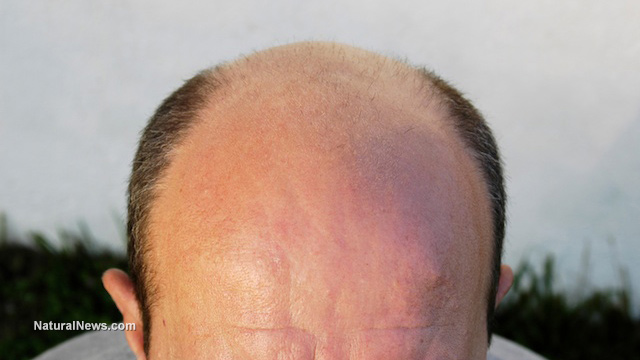Male pattern baldness linked to prostate cancer through hormonal imbalance
Wednesday, March 16, 2016 by: David Gutierrez, staff writer
Tags: male pattern baldness, prostate cancer, hormonal imbalance

(NaturalNews) Men with a specific pattern of hair loss by age 45 are 40% more likely to be diagnosed with aggressive prostate cancer, according to a study conducted by researchers from the National Cancer Institute and published in the Journal of Clinical Oncology.
"Our study found an increased risk for aggressive prostate cancer only in men with a very specific pattern of hair loss, baldness at the front and moderate hair-thinning on the crown of the head, at the age of 45," senior author Michael B. Cook, PhD, said. "But we saw no increased risk for any form of prostate cancer in men with other hair-loss patterns."
Frontal baldness most dangerous
Previous research has shown that hair loss and prostate cancer share a number of risk factors, including a family history and elevated levels of the male sex hormone dihydrotestosterone (DHT).A 2013 study by researchers from the University of Pennsylvania found that, among African American men between the ages of about 35 and 90, those with baldness were about 69% more likely to be diagnosed with prostate cancer. That study, however, included only about 500 participants.
The new study included 39,070 men between the ages of 55 and 74 (mostly in their 70s) who were asked to use a pictorial tool to demonstrate what their hair-loss patterns had been like at the age of 45. All participants were taking part in the US PLCO Cancer Screening Trial and had no history of cancer, with the exception of non-melanoma skin cancer, at the study's start. Approximately half reported that they had experienced some form of hair loss already by age 45.
In three years of followup, 1,138 participants were diagnosed with prostate cancer, and 571 of these cases (51%) were classified as aggressive. The average age at diagnosis was 72.
The researchers found that men who reported frontal and moderate crown baldness at age 45 were 40% more likely to be diagnosed with prostate cancer than men without any hair loss at that age. Men with frontal baldness were actually twice as likely to be diagnosed with aggressive prostate cancer. There was no connection, however, between other forms of baldness and aggressive prostate cancer, or between any form of baldness and non-aggressive prostate cancer.
The study is the largest to date to show a connection between baldness and prostate cancer.
"While our data show a strong possibility for a link between the development of baldness and aggressive prostate cancer, it's too soon to apply these findings to patient care," Cook said. "There is a wide confidence in our estimated 40% increased risk. The lower confidence limit suggests just a 7% increased risk in these men."
More research underway
The authors emphasized that further research is needed, both to confirm the connection and to explain it."If the association between frontal plus moderate vertex balding and increased aggressive prostate cancer risk is replicated in other studies, then mechanistic studies may be warranted to help understand the links underlying this association," Cook said.
The researchers are already planning two followup studies, looking not just at the risk of developing prostate cancer but also at the risk of dying from it. One study will use a dermatological assessment to determine baldness, rather than using the less reliable self-reporting recall method.
Two other studies are currently underway to examine a potential connection between prostate cancer and baldness: the Vitamins and Lifestyle (VITAL) Cohort Study by researchers at the Fred Hutchinson Cancer Research Center and the National Health and Nutrition Examination Survey (NHANES) I follow-up study (NHEFS) by the Centers for Disease Control.
Sources for this article include:
http://www.medicalnewstoday.com
http://www.philly.com
http://www.washingtonpost.com
http://www.cancernetwork.com
http://science.naturalnews.com
Male pattern baldness at FETCH.news
Get independent news alerts on natural cures, food lab tests, cannabis medicine, science, robotics, drones, privacy and more.
Take Action: Support Natural News by linking to this article from your website
Permalink to this article:
Embed article link: (copy HTML code below):
Reprinting this article:
Non-commercial use OK, cite NaturalNews.com with clickable link.
Follow Natural News on Facebook, Twitter, Google Plus, and Pinterest
- Newly released JFK files reveal Pentagon's role in creating Lyme disease and covid in the same lab
- Trump's greatest betrayal so far: Accelerating Middle East wars, silencing dissent, and serving Zionist masters
- The hidden dangers in your kitchen: How cooking methods impact diabetes, cancer and aging
- DEADLY DECEPTION: How COVID vaccines increased mortality rates and why authorities hid the truth
- STARDUST, a secretive Israeli-US startup, plans risky solar geoengineering experiment to BLOCK OUT THE SUN
- CDC finally halts $11 billion COVID funding scam as health officials admit the ‘pandemic’ was a fraud
- Arkansas embraces medical freedom with landmark ivermectin law
- Lab leak confirmed? Boris Johnson's stunning reversal on COVID origins sparks global debate
- Home gardening for preppers: A beginner's guide to growing your own food
- GAIN-OF-FUNCTION CAT-BIRD-FLU now on the rise as nearly a dozen cats in Colorado "test positive" for Bird Flu due to contaminated cat food
- Unraveling the paradox: Why intelligent individuals fall prey to everyday blunders
- Cartels shift tactics: Kidnappings and organ trafficking surge as border crossings plummet under Trump policies
- YouTube’s double standard: CEO defends censorship while claiming free speech champion status
- “Feel G.O.O.D. Gut Health Program” on BrightU: Why elimination diet is good for you
- “Rent-a-womb” scandal: How China is exploiting U.S. birthright citizenship for long-term espionage
- Why you should think twice before buying mainstream toothpaste formulas
- Was JFK's assassination orchestrated by a CIA double agent? New evidence points to James Angleton as the “architect”
- Record honeybee deaths devastate U.S. agriculture, pesticides under scrutiny
- Newly released JFK files reveal Pentagon's role in creating Lyme disease and covid in the same lab
- Elon Musk: Aliens could be here on Earth RIGHT NOW
- Festive flavors: The sweet history, nutritional profile and health benefits of pecan pie
- Trump reverses course on Gaza plan, says “nobody is expelling Palestinians”
- Reclaim your health: How midlife exercise reverses years of inactivity
- Big Pharma's $8 Billion bribery scheme exposed: how doctors are pushed to prescribe junk science, not heal
- Boys are back in town: Trump’s patriotic alpha crew takes the wheel while toxic females ride in the backseat
- EPA advisor admits the agency is funneling billions to climate groups ahead of Trump’s return to White House
- Space war brewing? Russia threatens to destroy Starlink satellites
- Survival 101: Effective EMF blocking techniques
- A lack of integrity in Academia: Harvard professor found GUILTY of fraudulent research to promote CRT theory
- Mike Adams Sermon 66: God will DESTROY ISRAEL for its wickedness
- 5 Simple steps to boost your brainpower: How to strengthen executive function in a distracted world
- Rep. Nancy Mace introduces bill to ban biological males from female facilities on federal property
- Sugarcane extract superior to cholesterol-lowering drugs?
- WHO focusing more on policing speech about public health and implementing global surveillance systems
- Pilots report mysterious lights 'moving at extreme speeds' across Oregon skies
- Dr. Mike Yeadon releases 15-minute testimony - WATCH - about genocidal intent of COVID “vaccines”
- EPA advisor admits the agency is funneling billions to climate groups ahead of Trump’s return to White House
- The Health Ranger releases “Vaccine Zombie” song and music video, using AI-animated zombies for the music video
- California's social media censorship law struck down: A victory for free speech or a threat to online safety?
- Dr. Mike Yeadon releases 15-minute testimony - WATCH - about genocidal intent of COVID “vaccines”
- The pandemic as a tool for INDOCTRINATION: Understanding “The Indoctrinated Brain” by Dr. Michael Nehls
- Florida takes a stand: DeSantis proposes permanent ban on mRNA vaccine mandates
- Mike Adams releases country western hit single: Goin’ Back in Time is Comin’ Home
- Mike Adams releases music poetry sensation: A Child of God
- “Why we influenced the 2020 elections”: Facebook files reveal the coordinated effort to bury the Hunter Biden laptop story
- RFK Jr. clears key hurdle: Sen. Susan Collins backs controversial HHS nominee, signaling a new era for health policy
- Unpacking the Lies That We’ve Been Fed – new song and music video released by Mike Adams, the Health Ranger
- Mike Adams releases new song and music video: Nothing More Disgusting Than a Globalist
- Newly released JFK files reveal Pentagon's role in creating Lyme disease and covid in the same lab
- Congratulations to the FULLY UNVACCINATED as you resisted the COVID-19 PROPAGANDA MACHINE fueled by over $100 BILLION
- Michigan sheriff announces criminal investigation into 2020 election crimes, Dominion Voting Systems
- Israeli soldiers accused of even more torture and abuse in the West Bank
- Migrants are taking advantage of recent hurricanes to scam residents and loot their homes
- House Intelligence Committee calls for the ARREST and PROSECUTION of Dr. Anthony Fauci
- Red Cross issues warning to stop blood plasma donations from vaccinated people
- Scientists confirm: GENIUS brain function can be spontaneously unleashed in humans without any apparent cause
- EPA advisor admits the agency is funneling billions to climate groups ahead of Trump’s return to White House
- HYSSOP: What research reveals about the health benefits of this ancient holy herb
- Two containers with completed ballots fall out of truck in Florida
- Fully vaccinated about to see “tsunami” of illness and death, warns virologist
- Global leaders unite to clamp down on “misinformation” with UN-backed Cascais Declaration
- BREAKING: 2025 NDAA authorizes mandatory military draft of WOMEN across America… as Pentagon pursues global NUCLEAR war with both Russia and China at the same time
- Michael Yon warns of a ZIONIST TAKEOVER in Trump’s second administration
- BOMBSHELL: DNA testing kits are a SCAM to develop ethnic-specific bioweapons
- Ozempic and Wegovy weight loss drugs are injectable LIZARD VENOM PEPTIDES that may unleash a devastating wave of organ failure… side effects align with symptoms of SNAKE BITES
- Israeli soldiers accused of even more torture and abuse in the West Bank
- These 13 countries just signed an agreement to engineer a global FAMINE by destroying food supply
- NASA admits that climate change occurs because of changes in Earth’s solar orbit, and NOT because of SUVs and fossil fuels
- RFK Jr. clears key hurdle: Sen. Susan Collins backs controversial HHS nominee, signaling a new era for health policy
- Sermon 30: How Jesus reveals Caesar’s FAKE CURRENCY and FALSE AUTHORITY
- Coriander seeds: Ancient medicine backed by modern science
- Arizona officials claim Maricopa County needs 10-13 days to tabulate results of the election
Science News & Studies
Medicine News and Information
Food News & Studies
Health News & Studies
Herbs News & Information
Pollution News & Studies
Cancer News & Studies
Climate News & Studies
Survival News & Information
Gear News & Information
News covering technology, stocks, hackers, and more



"Big Tech and mainstream media are constantly trying to silence the independent voices that dare to bring you the truth about toxic food ingredients, dangerous medications and the failed, fraudulent science of the profit-driven medical establishment.
Email is one of the best ways to make sure you stay informed, without the censorship of the tech giants (Google, Apple, Facebook, Twitter, YouTube, etc.). Stay informed and you'll even likely learn information that may help save your own life."
–The Health Ranger, Mike Adams












































